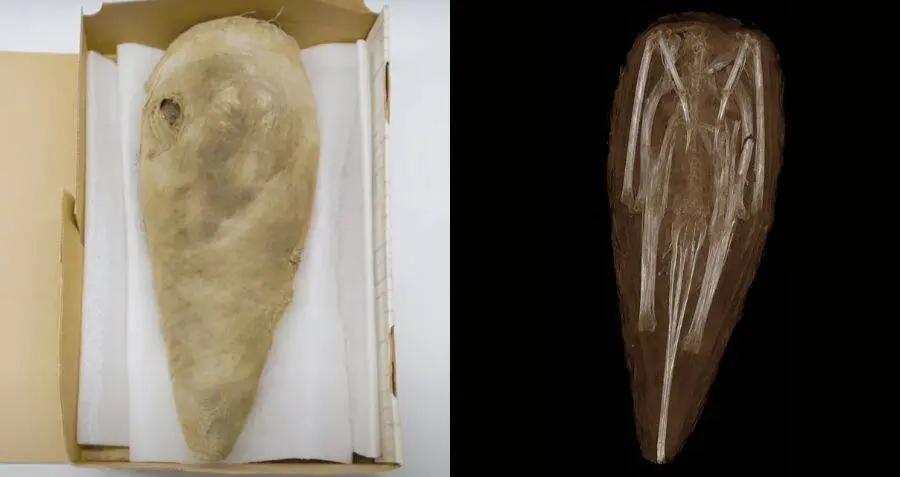For almost one hundred years, the tiny, two-pound mummy sat in storage at Cornell University. Mislabeled as a “hawk mummy,” it didn’t draw much attention until a graduate student picked it up for an experiment. Then, the mysterious mummy was revealed as an ibis, a sacrificial bird used by ancient Egyptians.

“Not only was this once a living creature that people of the day may have enjoyed watching stroll through the water,” Carol Anne Barsody, a graduate student in archaeology, told the Cornell Chronicle. “It also was, and is, something sacred, something religious.”
Barsody first stumbled upon the mummy as part of her research. Hoping to study how technology could be integrated into museum exhibits, she reached out to Frederic Gleach, curator of Cornell’s Anthropology Collections. He alerted her to two small mummies which had sat in a closet for nearly one hundred years. One was full of twigs; the other contained a bird.
Both Barsody and Gleach were determined not to disturb the mummy. They wanted to use technology to study it without destroying it.
“Much of archaeology is destructive,” Gleach told the Cornell Chronicle. “Once you’ve excavated something, there’s no unexcavating it. Once you’ve unwrapped a mummy, there’s no putting it back together again.”
As such, they brought the “hawk mummy” to the College of Veterinary Medicine (CVM). There, according to CNN, CT scans revealed that the bird was a male ibis, not a hawk. Not only that, but it was likely between 1,000 and 3,000 years old, and some of its soft tissue was still intact.
Ancient Egyptians sometimes sacrificed these long-legged birds to the god Thoth. Often depicted with the head of an ibis, Thoth was the god of the moon, reckoning, learning, and writing. Live Science reports that millions of these birds have been found in Egyptian necropolises.
But significant mysteries swirl around the ibis found at Cornell. For starters, researchers found that the bird’s head had been twisted back and laid against its body — which accounts for the mummy’s unusual shape. The ibis’ rib cage and sternum had also been removed which, according to the Cornell Chronicle, “was not a common practice.”

Ryan Young/Cornell UniversityFrederic Gleach, with Barsody in the background, examines the ibis mummy.
What’s more, Barsody isn’t exactly sure how the ibis made its way from Egypt to Ithaca, New York, where Cornell is located. At first, she thought that the ibis mummy may have accompanied a human mummy named Penpi, who arrived at the university in 1884. But Penpi appeared to have arrived without other artifacts.
Presently, Barsody suspects that the ibis mummy may have been donated to Cornell in 1930 by an alumnus who sent a number of artifacts to the school from Saqqara, Egypt. To learn more, she’s hoping to compare its DNA with the DNA of other ibises found in Egyptian tombs, which might help narrow down when and where it lived.

Barsody also has larger goals for the ibis itself. For her, the next step is to create a 3D image of the ibis, which will be turned into a hologram, as well as a digital file that people could download onto their cell phones.
“I come from a very small town, and we don’t have any museums near where I grew up or that were easily accessible,” she told CNN. “Really the first time that I was able to visit a museum was when I was in university, which is crazy to think about.”
To the Cornell Chronicle, she added: “The goal is to gauge the public’s readiness for exhibitions without the artifacts. That gets into bigger questions about repatriation, institutional collecting practices, access, and education in this post-COVID world, where you might not be able to actually get to a museum. I’m really interested in the multisensory aspects. Using not just your sight, but also feel, smell, hearing.”
Simply put, she said, “I want to bring the bird back to life.”





